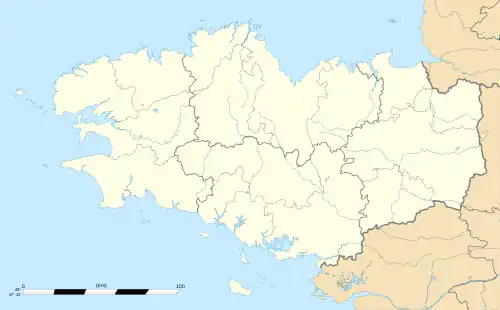Étel
Étel (French pronunciation: [etɛl]; Breton: An Intel) is a commune in the Morbihan department of Brittany in north-western France.[3] Inhabitants of Étel are called in French Étellois.
Étel
An Intel | |
|---|---|
 The town hall in Étel | |
.svg.png.webp) Coat of arms | |
Location of Étel | |
 Étel  Étel | |
| Coordinates: 47°39′30″N 3°11′58″W | |
| Country | France |
| Region | Brittany |
| Department | Morbihan |
| Arrondissement | Lorient |
| Canton | Quiberon |
| Intercommunality | Auray Quiberon Terre Atlantique |
| Government | |
| • Mayor (2020–2026) | Guy Hercend[1] |
| Area 1 | 1.74 km2 (0.67 sq mi) |
| Population | 2,053 |
| • Density | 1,200/km2 (3,100/sq mi) |
| Time zone | UTC+01:00 (CET) |
| • Summer (DST) | UTC+02:00 (CEST) |
| INSEE/Postal code | 56055 /56410 |
| Elevation | 0–17 m (0–56 ft) |
| 1 French Land Register data, which excludes lakes, ponds, glaciers > 1 km2 (0.386 sq mi or 247 acres) and river estuaries. | |
La Glacière d’Étel
Once a bustling fishing port, La Glacière, or the ice house, stands as a testament to the town's rich maritime heritage. Erected in 1946, La Glacière d’Étel played a vital role in producing ice for the local port, supporting the needs of a fishing fleet that, until the 1950s, comprised 250 sailing boats primarily engaged in tuna fishing. This architectural relic, the last remaining ice house in Morbihan, Brittany, fell into disrepair after its heyday. However, in a forward-looking initiative, local authorities have undertaken its restoration, blending the town's history with a sustainable future in green energy.[4]
According to Étienne, a representative involved in the restoration project, "The main objective of our project is to welcome the public." La Glacière, now a focal point of historical preservation and innovation, hosts exhibitions, with the current one dedicated to maritime energy in Brittany. The restoration project incorporates cutting-edge technologies, aligning with a commitment to green energy. A tidal turbine and a heat pump are integral to harnessing the sea's energy, with a focus on utilizing local energy sources.[4]
Aurélien Bertin, advisor to La Glacière d’Étel Energy Project at VALOEN, elucidates, "We are going to use as a priority here at La Glacière all the sources of energy that we can find here nearby." The sea becomes a pivotal source, with seawater serving a dual purpose. The tidal turbine harnesses the sea's current to generate electricity, while a seawater heat pump taps into the relatively constant temperature of seawater throughout the year to recuperate calories for heating the building—a process akin to an inverted fridge.[4]
In a nod to sustainability, the curved roof of La Glacière is adorned with innovative biodegradable and flexible solar panels, a product of design ingenuity from Nantes. Surplus energy generated will be shared with local municipal buildings, reinforcing a commitment to community-wide benefits.[4]
Supported by nearly €166,000 in European funding, the La Glacière energy project exemplifies a harmonious blend of historical preservation, renewable energy innovation, and community engagement, providing a model for similar endeavors across the region.[4]
See also
References
- "Maires du Morbihan" (PDF). Préfecture du Morbihan. 7 July 2020.
- "Populations légales 2020". The National Institute of Statistics and Economic Studies. 29 December 2022.
- INSEE commune file
- "How an ice house restoration is bringing life back to a French seaport". euronews. 5 June 2023. Retrieved 29 September 2023.
External links
- Cultural Heritage (in French)
- Mayors of Morbihan Association (in French)